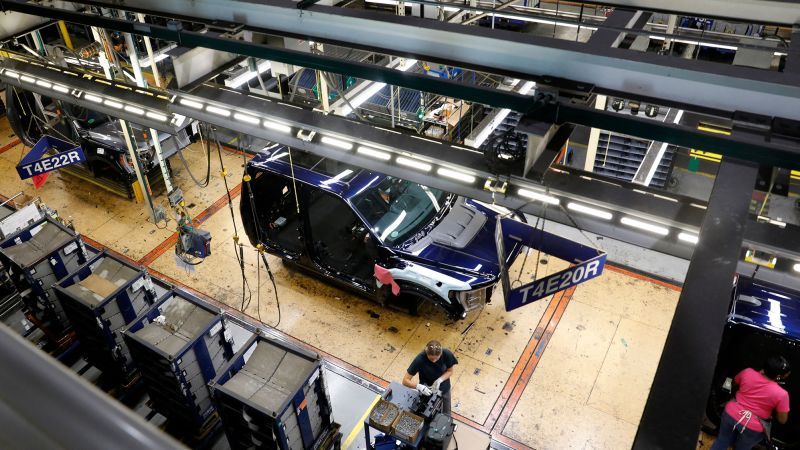Ford's EV losses climb but overall profits rise
New York CNN —
Losses are going up on Ford’s electric vehicle business, but profit from its traditional internal combustion engine vehicles allowed it to beat Wall Street expectations.
The company earned 72 cents a share in the second quarter on an adjusted basis, up from 68 cents a share and better than the 55 cents a share forecast by analysts surveyed by Refinitiv. Automotive revenue rose 12% to $42.4 billion, $2 billion more than forecasts.
The company was able to beat the estimates despite the fact that its losses before interest and taxes (EBIT) grew to $1.1 billion from its EV business, which the company calls its Model e division, up from the $722 million EBIT losses in the first quarter.
And those losses are going to rise, at least in the short term. Ford said it expects a Model e EBIT loss of $4.5 billion for the full year, up from its earlier forecast of a $3 billion loss for all of 2023. And it pushed back when it expects to start producing EVs at a 600,000 annual pace to some time in 2024, rather than by the end of 2023. It said the pricing environment for EVs was one of the main reasons for the new loss estimate.
EV leader Tesla has been regularly cutting prices throughout this year. In response, other automakers, including Ford, have responded with EV price cuts of their own.
But the company’s Ford Blue division, which makes most of its gas-powered consumer vehicles, posted $2.3 billion in EBIT profits, while Ford Pro, which is its commercial vehicle division selling primarily traditional internal combustion vehicles, contributed $2.4 billion.
The company raised its full-year adjusted EBIT target to between $11 billion and $12 billion, up from its earlier guidance of $9 billion to $11 billion.
Ford CEO Jim Farley said that “pricing pressure [for EV’s] has dramatically increased in the last 60 days.”
“EV price premiums over internal combustion vehicles fell more than $3,000 in the second quarter and nearly $5,000 in first half,” said Farley. “We expect the EV market to remain volatile until the winners and losers shake out.” But he confidently predicted that Ford “will be one of the winners.”
Still Ford, like the other traditional automakers moving to shift from ICE vehicles to EVs, is losing money at this stage. Ford’s numbers work out to a loss of about $32,000 per EV that it sold in the second quarter, compared to a profit of $3,200 per vehicle sold by the Ford Blue division.
CFO John Lawler said Ford still expects to hit its target to be making an 8% profit on its EVs business by 2026. Farley said the company’s next generation of EVs, still under development, will be far more profitable for the company than its current EV offerings.
Contentious labor negotiations loom
Ford would have trouble coming anywhere near its 2023 earnings target should the United Auto Workers union go on strike against the company later this year. The current contract between the UAW and the “Big Three” unionized US automakers — Ford, General Motors and Stellantis — expires on Sept. 14.
History in recent decade suggests that the UAW will not strike all three companies at the same time. It could do what it has done in the past and pick one company as the “target” of it negotiations, and perhaps go on strike against it if there is no deal.
Ford has not been struck by the UAW since 1976, far longer than the other two automakers have gone without a strike. And Farley tried to assure investors that a deal can be reached this time without a work stoppage.
“When it comes to building in America and partnering with UAW, Ford stands out from all the other automakers, and most other major industrial companies,” he said. “So although these negotiations promise to be challenging, our goal is to build a bridge to the future with our employees based on mutual trust and a spirit of problem solving with the UAW leadership, and of course, our incredible workforce.”
But negotiations are off to a contentious start as Sean Fain, the union’s new president who was elected with a vow to take a hard line in auto talks, has said the union is prepared to go on strike against all three companies. He refused the tradition of recent decades of starting negotiations posing for a handshake with each of the auto chief executives across the bargaining table.
And there is no issue on which he and the UAW has been more critical of the automakers than their plans to shift to making nothing but EVs in coming decades.
Because they have fewer moving parts, EVs are estimated to need about one-third fewer hours of work to assemble. And much of the assembly time is building the large battery packs that power the cars.
But the automakers don’t plan to build the batteries themselves but instead have battery plants manufacture them. And for the most part those plants are to be owned by joint ventures the auto companies establish with battery makers and are likely to pay workers roughly half the wages that UAW members are paid at the existing Big Three factories.
Fain has attacked a $9.2 billion loan that Ford and Korean battery maker SK received to finance construction of three battery plants. And Thursday, Fain said the strong earnings and profit outlook at Ford, as well as previous strong earnings reports at GM and Stellantis, prove they can afford to meet UAW demands and to pay workers at EV battery plants far more more than now expected to be offered.
“Like every Big Three automaker, Ford is thriving. These eye-popping numbers come on top of a decade of massive profits,” Fain said. “The Big Three made a quarter-trillion dollars in North American profits over the last decade, but they denied UAW members our fair share. No Ford worker should wonder if the Blue Oval battery plants opening across the country will start a race to the bottom that undermines standards for all autoworkers. Seeing the billions that Ford is making, we know they can and must make things right for our workers and our communities.”
Source: CNN


